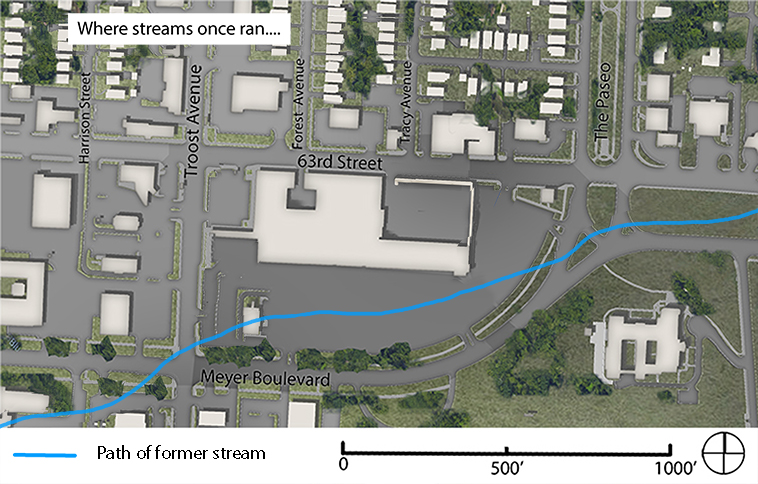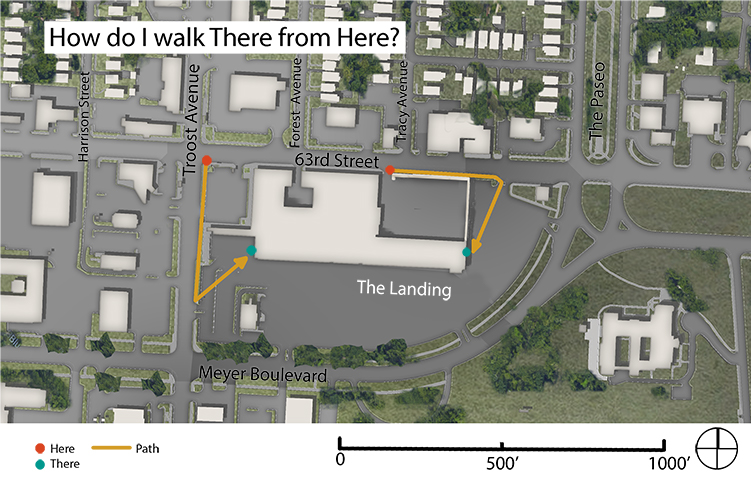The Landing at 63rd and Troost has been under-serving the Kansas City community for some time. The area is dominated by large parking lots, low-intensity commercial structures, and an outdated shopping mall. Poor design in the area has led to a number of issues that any redevelopment will need to address in order to be successful. Foremost of these is an expanse of impervious surfaces which negatively affect the environment and the poor design of the mall site at the center of the area.
Currently, a vast sea of asphalt and automobiles exists where a stream once flowed. The Landing is a topographical low point and, prior to the intervention of European settlers, the site was crossed by a small stream. However, early in the 20th century this stream was buried in underground culverts and its path is now covered-over with the mall’s large parking lot. The lack of a deep soil bed and plant life creates a condition in which water flows to this low ground and directly into the city’s grey-water sewers. There, it flows north and empties into Brush Creek. This creates a number of environmental problems. First, hazardous materials and toxins, which are deposited throughout the watershed by human activity, will flow directly into the fragile ecosystems of downstream waterways (Salerno). This can contribute to environmental damages across the continent, from Kansas City to the Gulf of Mexico, as the waste is carried to larger bodies of water. Secondly, during major rain events, the volume of water flowing downstream is greatly increased. In a natural setting, rainwater will soak into deep soil where it can absorbed slowly by plant life, seep into natural aquafers, or flow into larger waterways and be carried downstream (Gill). When impervious surfaces prevent the first two possibilities from occurring, great volumes of water will flow directly downstream. As this action is compounded by the proliferation of impervious surfaces in exurban sprawl, the excess runoff may lead to more frequent and more damaging flooding events (Salerno).

The Landing, in its current state, lacks an identity of place. Much of this is due to its odd design and misuse of the natural topography. This lack of identity has left the site with undervalued commercial spaces, leaving it vulnerable to occupation by exploitative businesses who seek to take advantage of the low-income, minority community to the east. The site is oddly disjointed from its upper level, along 63rd Street, to its lower level, facing the sea of parking along Meyer Blvd. There is no clear connection between the two sides of the mall. Pedestrian paths from the upper to the lower level are non-existent. At the western edge, along Troost, a utilitarian, mid-block ramp has long been blocked off. Pedestrians must walk further south, to an automobile curb-cut, cross a vast sea of parking (without the comfort of a sidewalk) just to reach a lower level entrance. To reach the lower level via an eastern route, a pedestrian must travel past a large, blank wall, enter the lower lot via another auto curb-cut, and search for the unmarked entrance. The north of the site is dominated by the unbroken façade of the north wall, which looms over the pedestrian and makes a generous side-walk feel narrow. At the northwest corner, the wall gives-way to a small parking lot, fronted by a strip mall which seems disconnected from the larger portion of the site. The “heart” of the mall is ostensibly the lower-level interior corridor. At less than 70% occupancy this heart is apparently diseased. A quick stroll reveals the malady, low ceilings, no natural light, and architectural finishings that haven’t been updated since an early 1980’s renovation.

This poor design and lack of investment from ownership have likely made the mall unappealing to most reputable businesses. Without demand from higher-quality retail tenants, businesses which exploit the poorer communities to the east have entrenched themselves in the site. The two most visually dominant corners are occupied by a pay-day lender at the northeast, and a pawn-shop to the northwest. These industries have been singled out by researchers as particularly exploitative of low-income, minority communities (Karger).
Any redevelopment of the site should seek to remedy these two issues. The growing threat of climate change, and the more violent weather that it is predicted to bring, will require more careful management of our waterways. A green solution to managing water runoff at the site should be imperative in any design. To address the poor retail environment, any new development should focus on improving the pedestrian experience and creating a series of activity nodes at strategic locations on the site.
Gill, S., Handley, J., Ennos, A., & Pauleit, S. (2007). Adapting Cities for Climate Change: The Role of the Green Infrastructure. Built Environment,33(1), 115-133. doi:10.2148/benv.33.1.115
Karger, H. J. (2007). The “Poverty Tax” and America’s Low-Income Households. Families in Society: Journal of Contemporary Social Services, 88(3), 413–417. https://doi.org.proxy.library.umkc.edu/10.1606/1044-3894.3650
Salerno, F., Gaetano, V., & Gianni, T. (2018). Urbanization and climate change impacts on surface Water quality: Enhancing the resilience by reducing impervious surfaces. Water Research,144, 491-502.doi:10.1016/j.watres.2018.07.058